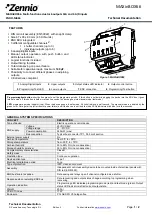
www.sentera.eu
MIW-DXTP-EN-000 - 29 / 09 / 2015
7 - 10
4.
Check if your unit starts or terminates the network (see
Example 1
and
Example 2
). If it does not, remove the JP1 (NBT) jumper. (See
Fig. 4
Network bus
resistor jumper.
)
Example 1
Example 2
Fig. 4 Network bus
resistor jumper
Slave 1
RX
ТX
NBT
NBT
NBT
Slave n
Master
Slave 2
Slave 2
Slave 1
RX
ТX
NBT
NBT
Master
Slave n
ATTENTION
If an AC power supply is used with any of the units in a Modbus network, the
GND terminal should NOT BE CONNECTED to other units on the network or
via the CNVT‑USB‑RS485 converter. This may cause permanent damage to the
communication semiconductors and / or the computer!
5.
Mount the unit outside a duct with the tube mounted inside the duct but fixed
outside it.
5.1
Drill a tight-sealing hole according the correct tube section (Ø 13 mm).
5.2
Fix the flexible flange (
Fig. 5
) on the duct outer surface using the self-
drilling screws, delivered with the unit. Then install the tube inside the
flexible flange. Mind the airflow direction.
5.3
Install the tube at the desired depth in the duct using the screw in the
flexible flange.
5.4
Install and connect the cables with a “drip loop”. You can also fix the unit
outside the duct via the mounting holes and as per the drawing shown
in
Fig. 6
.
Fig. 5 Fixing flange
Fig. 6 Mounting dimension
2x Ø
5
60
4x Ø 4,
5
70
66
ATTENTION
Installation of the unit near high EMI‑emitting devices may lead to faulty
measurements. Use shielded wiring in areas with high EMI.
ATTENTION
Keep 15 cm (5,9’’) minimal distance between the sensor lines and the 230 VAC
power lines.
DXTP
DUCT TEMPERATURE CONTROLLER
WITH PI CONTROL




























